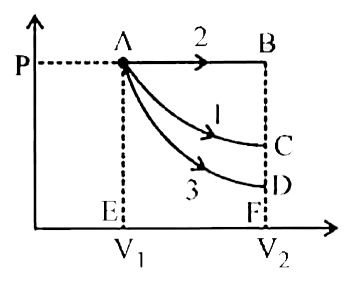With same initial conditions , an ideal gas expands from volume V1 to V2 in three different ways . The work done by the gas is W1 if the process is isothermal , W2 if isobaric and W3 if adiabatic , then
W1>W2>W3
W2>W3>W1
W1>W3>W2
W2>W1>W3
The correct Answer is:D

On the corresponding P - V diagram, AC represents the isothermal change, AB represents isobaric change (pressure constant) and AD corresponds to adiabatic process (Slope of Adiabatic is more than the slope of isothermal) and for the indicator diagrams, the area under the graph gives the work done by the gas.
∴AreaABFE>AreaACFE>AreaADFE
∴W2>W1>W3
Topper's Solved these Questions
- KINETIC THEORY OF GASES ,THERMODYNAMICS AND RADIATIONBOOK - MARVEL PUBLICATIONCHAPTER - KINETIC THEORY OF GASES ,THERMODYNAMICS AND RADIATIONEXERCISE - TEST YOUR GRASP - 9
30 Videos
- INTERFERENCE AND DIFFRACTIONBOOK - MARVEL PUBLICATIONCHAPTER - INTERFERENCE AND DIFFRACTIONEXERCISE - TEST YOUR GRASP
20 Videos
- MAGNETIC EFFECTS OF ELECTRIC CURRENTBOOK - MARVEL PUBLICATIONCHAPTER - MAGNETIC EFFECTS OF ELECTRIC CURRENTEXERCISE - MCQ
195 Videos
Similar Questions
A sample of gas expands from volume V1 to V2. The amount of work done by the gas is greatest when the expansion is
View SolutionStarting with the same initial conditions, an ideal gas expands from volume V1 to V2 in three different ways, the work done by the gas is W1 if the process is purely isothermal, W2 if purely isobaric and W3 if purely adiabatic, then
View Solution
Knowledge Check
Starting with the same initial conditions, an ideal gas expands from volume V1 to V2 in three different ways, the work done by the gas is W1 if the process is purely isothermal, W2 if purely isobaric and W3 if purely adiabatic, then
AW2>W1>W3BW2>W3>W1CW1>W2>W3DW1>W3>W2Starting with the same initial conditions, an ideal gas expands from volume V1 to V2 in three different ways. The work done by the gas is W1 if the process is purely isothermal, W2 if purely isobaric and W3 is purely adiabatic. Then
AW2>W1>W3BW3>W1>W1CW1>W2>W3DW1>W3>W2Starting with the same initial conditions, an ideal gas expands from volume V1→V2 in three different ways. The work done by the gas is W_1 if the process is purely isothermal, W2if purely isobaric and W3 if purely adiabatic. Then
 AW2>W1>W3BW1>W2>W3CW2>W3>W1DW2>W1>W3
AW2>W1>W3BW1>W2>W3CW2>W3>W1DW2>W1>W3
Starting with the same initial conditions, an ideal gas expands from volume V1 to V2. The amount of work done by the gas is greatest when the expansion is
View SolutionA sample of gas expands from volume V1 to V2 .The amount of work done by the gas is greatest when the expansion is
View SolutionA gas expands under constant pressure P from volume V1 toV2The work done by the gas is
View SolutionA sample of gas expands from volume V1 to V2. The amount of work done by the gas is greatest when the expansion is
View SolutionEntrolpy change in isothermal expansion work of one mole of an ideal gas from volume V1 and V2 is given by
View Solution
